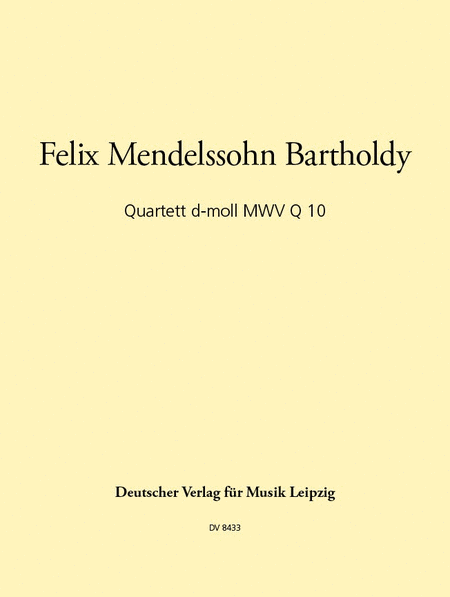Quartet in D minor MWV Q 10
Details
Description
SKU: BR.DV-8433
Composed by Felix Bartholdy Mendelssohn. Edited by Wulf Konold. Chamber music; Softbound. Deutscher Verlag.This stroke of genius breezily whipped up by the 12-year old composer borrows from Haydn, Mozart and Schubert, yet it still attains an individuality.
Romantic period. Full score and solo. 64 pages. Deutscher Verlag fur Musik #DV 8433. Published by Deutscher Verlag fur Musik (BR.DV-8433).ISBN 9790200482836. 9 x 12 inches.
The early works of Felix Mendelssohn Bartholdy, which remained unpublished during the composer's lifetime, only began to claim the attention of musicologists, and thus of musicians and music lovers, a little over 35 years ago. In 1959, during the Mendelssohn anniversary year, it was decided to issue a new critical Complete Edition which would do full justice to present-day philological demands: the "Leipziger Ausgabe der Werke Felix Mendelssohn Bartholdys". The unpublished early works, thus those written between 1821 and 1825, occupied center stage in this edition: the string symphonies were released, as well as the concertos for solo instrument and orchestra, the Singspiel Die beiden Padagogen and sacred choral music. Chamber music was equally important to the young Mendelssohn. He wrote sonatas for various solo instruments (violin, viola and clarinet) and piano, a series of String Quartet Fugues, a String Quartet in E flat major, a Piano Trio in C minor (unconventionally scored for violin and viola), and the Piano Quartet in D minor published here for the first time. According to the results of the stylistic examination and the transmission of the manuscript, this latter work must have been written during the summer or fall of 1821, thus in very close proximity to the first string symphonies. Many of the score's details reflect the 12-year-old composer's intensive study of Mozart's music; however, the work unquestionably contains individual traits as well. lt is in three movements; unlike the Piano Quartets Opp. 1-3 written between 1822 and 1825, it contains no dance movement. The first movement is in sonata form. lts harmonic shifts sometimes recall Schubert, although Mendelssohn could not possibly have known him at that time. The second movement, a romance-like Andante, boasts a middle section abounding in turbulent figures (stylistically reminiscent of the Romance from Mozart's Piano Concerto K. 466). The Finale-Rondo "all'Ongharese" is full of entertaining moments and has an unmistakable Haydnesque touch. The autograph of the Piano Quartet in D minor has come down to us in Volume 3 of the "Green Books" which constitute the largest part of the musical autographs in the composer's estate and are preserved today in the Music Division of the "Staatsbibliothek zu Berlin - Preussischer Kulturbesitz". This autograph, from which it is impossible to judge whether the work was ever performed during the composer's lifetime, is the only source of the work and was taken as the basis for this first edition. Following the principles of modern-day textual criticism, this edition has attempted above all to be faithful to Mendelssohn's compositional intentions. Only obvious errors or oversights were corrected. These emendations have been marked as such, along with the editor's additions which essentially concern missing accidentals as well as suggestions for the dynamics and the phrasing. The edition was prepared in 1983/84 and was first used for a complete recording of Mendelssohn's four piano quartets. The public world premiere of the Piano Quartet in D minor took place in Berlin on 7 September 1986. The editor wishes to express his thanks to the Music Division of the Staatsbibliothek zu Berlin for its permission to publish the work, and to the publishers thanks to whom this work - after the planned publication failed to come through following the world premiere - is now being made accessible to the musical world during this Mendelssohn anniversary year. Wulf Konold, Spring 1997
This "stroke of genius" breezily whipped up by the 12-year old composer borrows from Haydn, Mozart and Schubert, yet it still attains an individuality.

 Share
Share